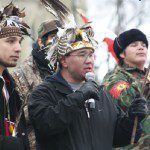The Native People’s Choice
The student's in Western's native journalism program face a dilemma: jump into the mainstream or devote their talents to the community
The Program in Journalism for Native People at the University of Western Ontario changed Juanita Rennie’s life. The intense, 12-month course prepared her and six other graduates of PJNP’s first class for entry-level media positions. Rennie, then a 40-year-old mother of six and grandmother to three, graduated in 1981 knowing exactly what to do next: “I wanted to show people-anyone who would listen-that there are positive things happening in the native community.”
Although Rennie grew up an urban Indian on the outskirts of Toronto with little knowledge of her ancestors’ culture, her ambition was typical of the program’s early students. The idea of a special journalism school to help natives achieve their aspirations arose in the 1970s, after an emerging political consciousness in the Canadian aboriginal community led to a dramatic increase in native media activity.
There’s been a change in recent years, however, and Allan Chrisjohn, PJNP’s current director, says many more students are considering entering the mainstream media. Still, very few do-and Dennis Martel, its director from 1982 to 1985, wonders if PJNP hasn’t outlived its usefulness and is in danger of becoming moribund. “As long as it’s just for natives, then the students are going to go into native journalism,” he says. “We felt they should be journalists-not Indian journalists. It’s becoming a bit of a cultural ghetto.”
Martel’s concern mirrors a dilemma facing many aboriginal Canadians: whether to enter the mainstream of Canadian society or to work from within the confines of their community. Chrisjohn says that PJNP graduates are equipped with the skills to work wherever they want, and opportunities in the mainstream media have never been better. Since the introduction in 1986 of the federal Employment Equity Act which requires broadcasters to hire aboriginal peoples and other visible minorities, Chrisjohn has received “all kinds of inquiries” from the media asking for applications from PJNP students. But despite the Act-and the students’ own aspirations and training-only a handful of graduates have landed in the mainstream. Others feel it is un-challenging and not a place where native issues can be discussed in depth.
The mainstream wasn’t much of an issue when the program set up shop inside the staid stone walls of Middlesex College. Classes were held in the basement while the students from Western’s graduate journalism program, with which PJNP is affiliated, studied upstairs in more comfortable quarters. In 1983, Martel moved PJNP upstairs to help integrate the students culturally and socially, and to cut costs by sharing equipment and space. Two-thirds of this year’s budget of $175,000 was paid by the Secretary of State and the Department of Indian Affairs and Northern Development, which also pay many students’ tuition and living expenses. But PJNP isn’t a make-work project -it’s tough and the failure rate is high. Last year only four of its 14 students graduated, and past years have had similar failure rates.
Natives from the cities and reserves of every region in Canada, including 10 Inuit and three Metis, have enrolled in the program. They range in age from their late teens to midforties: four of this year’s students are in their forties. Western’s entrance requirements make allowances for older students like Rennie, who dropped out of school in Grade 10. “They usually make up for what they may be missing in formal education with a wealth of past life experiences,” says Chrisjohn.
For some, like 1982 grad Dan David, PJNP provides an invaluable second chance. He grew up near Montreal on the Kanehsatake reserve and planned to enter Carleton’s journalism program until a high-school counselor advised him he was better suited to bricklaying because he was good with his hands. After 10 years of odd jobs, David heard about PJNP and now works in Toronto as a writer and broadcaster for Infotape, CBC Radio’s syndication service.
Today PJNP has three native instructors including Chrisjohn, each with a long history in journalism. The program’s first native director, Chrisjohn believes that native instructors provide excellent role models, reminding students that native journalists can make it. Martel agrees this is important-but having the best teachers, no matter what their race, is crucial. A tribal elder once told him not to worry about being white: “You teach them to be journalists, I’ll teach them to be Indians.” Only one course deals specifically with aboriginal issues, training the students to analyze government policies by scrutinizing the Indian Act, the Constitution and documents on self-government and land claims.
All other courses focus on the basics of journalism, with the students publishing a newspaper and producing weekly half-hour radio shows and short video documentaries. A magazine course taken with the Western grads includes a competition for the best magazine mock-up, and PJNP students take great pride in the fact that, with only one-third of the grads’ enrollment, they’ve won about half the contests. David says one of the program’s few drawbacks is that students do not have time to take liberal arts courses which would provide the broader base of knowledge often required in the mainstream.
The students’ first opportunity to address a non-native audience usually comes at the end of the year when they are placed in a three-week intern program: last year, Global Television, London magazine, CHIN Radio and CKO Radio participated. According to Joe Snider, CKO’s London bureau chief and news director, PJNP students compare favorably with interns from other journalism programs and his last intern “was gung ho all the way. He knew what was required of him and went out and did it.”
Snider says CKO’s door will continue to remain open for PJNP students.
About half of this year’s class are considering walking through that door to a career in the mainstream. Their reasons vary. For some it’s the lack of money in native communications although a few are willing to postpone entering the mainstream until they’ve “paid their dues” for a couple of years in native media. Others, like Geoffery Johnston, simply don’t want to be limited to native communications. He knows what he eventually wants-a job with Hockey Night In Canada: “I am interested in native issues but I love hockey. I want to meet the stars.”
Despite these ambitions and encouragement from employers like Snider-almost all of this year’s grads will probably end up in native media. Rennie’s career is typical. After graduation she began reporting for a native newspaper, then spent two years as founding publisher and editor of SweetgrO$S, a national native magazine which folded after two issues. She went on to produce Native Express, a television series profiling native political and artistic leaders, and now contracts her skills to government agencies involved in native issues.
Sherry Huff, a 1988 graduate, is following in Rennie’s footsteps and is now a reporter with the Wawatay Native Communications Society at Sioux
Lookout in northern Ontario. Wawatay operates a radio and television station and publishes a monthly tabloid in both English and Oji-Cree syllabic. Huff plans to continue working on native issues but may eventually do so in the mainstream, using her experience at Wawatay “to build a stronger base of knowledge on native issues so I’ll know exactly what I’m trying to tell the Canadian people about native people.”
Huff was one of the PJNP grads who intended to enter the mainstream after graduating, and she did her internship at Global Television. For now she has chosen Wawatay because she believes her job, which includes flying into some of Ontario’s most isolated communities, is more challenging than an entry-level position at a Toronto television newsroom. Dan David puts the case more forcibly: he believes most grads work in native communications because that’s where the real stories on native issues get covered. The mainstream is only interested in them after a sit-in, blockade or blowup: “There’s no examination of the burning fuse that leads up to that explosion-only the body count afterwards.” He adds that many other natives “don’t feel comfortable at a white publication. They come in believing they’ve been hired as the token Indian.”
Throughout his career, David has rejected tokenism and any suggestion that only natives should cover native issues. After three years as a CBC- TV reporter in Regina, a new executive producer told him to take the native affairs beat. Instead, David let his contract expire, moved to Ottawa and supported himself as a freelancer.
Tokenism and providing role models are very different issues. In fact, one of the program’s most important achievements is that its graduates pro. vide role models for Canada’s native community: David was one of the first native journalists Regina’s large aboriginal population had seen on its local television news. As well as working on reserve newspapers and newsletters, grads may help research their bands’ land claims. Some get politically involved-one former student, Les Carpenter, became mayor of Sachs Harbour, NWT.
When the PJNP started, many native publications were little more than propaganda broadsheets published by inexperienced reporters. The program is partly responsible for raising their standards. And despite his misgivings Martel says, “PJNP did what it set out to do-it’s turned out some damn fine journalists. They’ve interpreted Indian concerns and Indian news to both Indian and non-Indian audiences.”
Western’s acting dean of journalism, Andrew MacFarlane, who was instrumental in the founding of the Program in Journalism for Native People, agrees with Martel that the program should ultimately self-destruct but feels “his timing is off.” Until there are a large number of native applicants in other journalism programs and many more native students enroll in regular university programs, MacFarlane says the program remains too positive a force in too many lives to shut down now. Graduates like Juanita Rennie agree. “If it wasn’t for PJNP,” she says, “I’d still be a waitress in Markham.”













